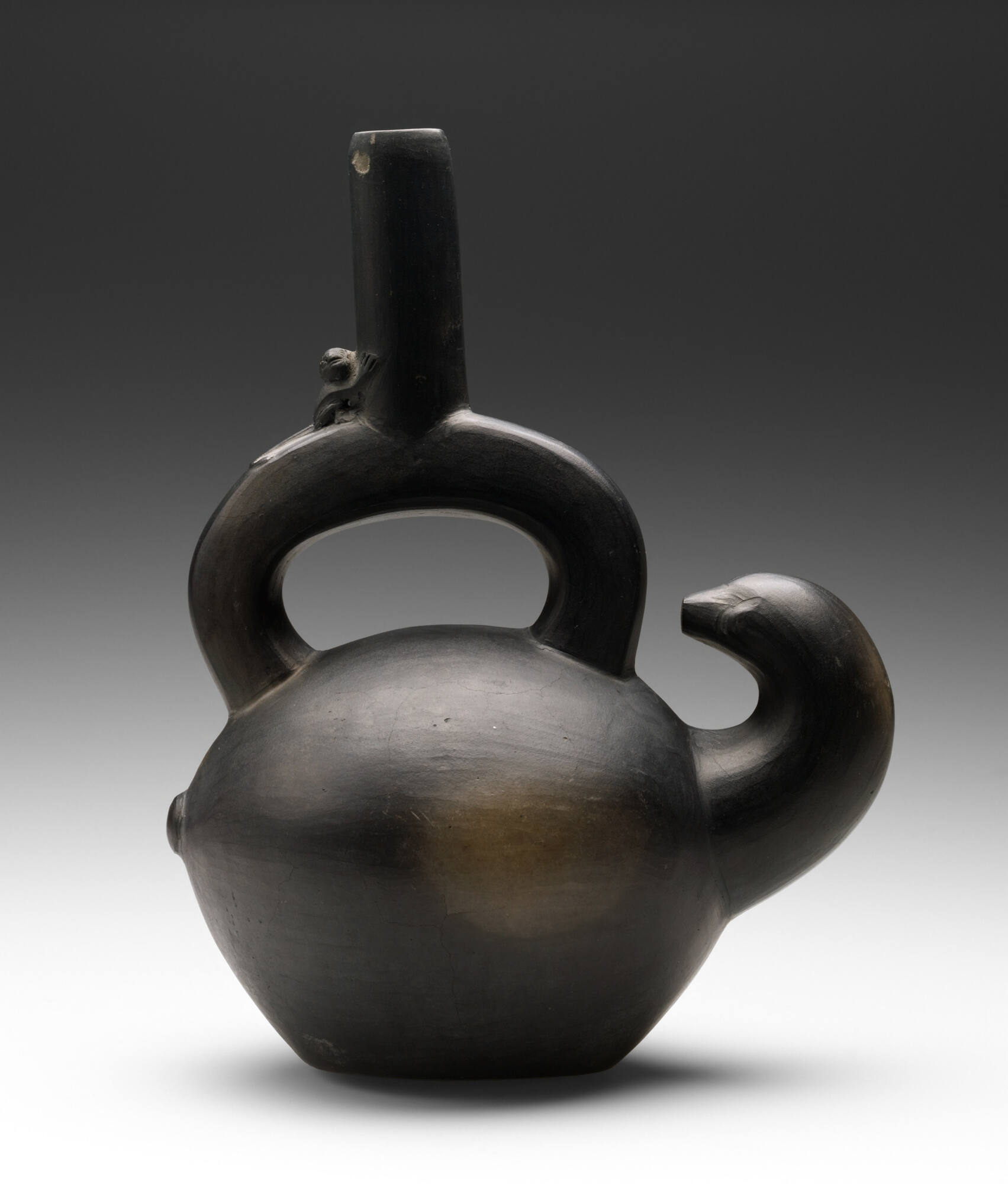
Object Details
Culture
Chimu (Peru)
Late Intermediate Period
Date
ca. 1300-1470
Medium
Blackware
Dimensions
9 3/8 x 7 1/2 inches (23.8 x 19.1 cm)
Credit Line
Transfer from the Sociology – Anthropology Department. Spring 1956.
Object
Number
56.159
BRIEF DESCRIPTION
An effigy vessel is a container that is made in the shape of a human or animal,(…)
BRIEF DESCRIPTION
An effigy vessel is a container that is made in the shape of a human or animal, or sometimes even a fruit or vegetable. This Chimú bottle is in the shape of a crookneck squash or gourd.
WHERE WAS IT MADE?
This bottle was made in what is now Peru.
HOW WAS IT MADE?
Chimú pottery was typically mass-produced using two-part press molds. First an original form was made from clay. After creating the mold (also ceramic) from this original, clay would be pressed into each half, and then later joined together. A variety of decorative motifs were molded in surface relief. Finally, the vessels were highly burnished prior to being fired in an earthen pit.
The black color of “blackware” is achieved in the firing process. While firing ceramics in a pit fire, the fire is smothered just enough to remove excess oxygen while still burning hot enough to fire the pottery. Unlike ceramics fired with plenty of oxygen, which may range in color from creamy buff to orange or red, ceramics fired in a “reducing” atmosphere will be gray or black in color.
HOW WAS IT USED?
The function of pre-Columbian ceramic vessels is not easy to ascertain. Were these vessels made for the dead, fancy grave goods with specific religious or mythical imagery, or were they treasured possessions used in life? Or both?
Although most pottery made in the past was functional ware used to cook, store, or serve foods, more elaborate pieces also conveyed social information. It appears that pre-Columbian people may have had special pots for display in their homes or for use during special occasions. According to the earliest chroniclers after the Spanish conquest, people put pottery on display in their homes that reflected what they did to make a living; for example, fishermen displayed pots with sharks in their homes, while hunters displayed pots with deer and other land animals. Perhaps the many pots made in the shape of common fruits and vegetables, such as squash and corn, were displayed in the homes of farmers.
Bottles of this stirrup-spout type may have been used to carry and serve liquids, since the narrow-necked bottle shape would have reduced losses from accidental spills and evaporation. Although water is vital in desert environments such as those found in many parts of the Andes, recent analyses of residues from Peruvian bottles and jars suggest that most of them were used to serve corn (maize) beer or chicha. Chicha was both an everyday beverage, made in households for family consumption, and an essential element in ritual and social interactions.
WHY DOES IT LOOK LIKE THIS?
Notice the small monkey at the base of the spout; this is a typical feature of Chimú-style ceramics. Monkeys live only in areas with abundant water resources, and therefore may symbolize water when found on the artwork of desert-dwelling people, such as the Nasca culture of coastal Peru. Monkeys are associated with agriculture and fertility, and because of their similarities to people, are sometimes depicted engaging in human-like activities, even in warfare. Among the Moche, monkeys are associated with coca-chewing; both are native to the moist, warm eastern slopes of the Andes. Perhaps because of the role played by both monkeys and coca in origin myths, monkeys are sometimes viewed as ancestor spirits. The Incas are said to have venerated the monkey for its cunning. Some cultures see monkeys as the embodiment of spirits, but they are hunted for food in the tropical lowlands where they are common.
The shape of this vessel is probably derived from a native Andean variety of squash. Squash and other vegetables are a common motif in Chimú ceramics, and many vessels were obviously made from molds using actual vegetables and fruits.
To see other pre-Columbian vegetable shaped vessels in the Johnson Museum’s collection, search for object numbers 56.184, 2003.043.005, 2006.070.044, and 2006.070.143 in the keyword search box.
ABOUT THE CHIMÚ CULTURE:
The Chimú Empire, or Kingdom of Chimor, was established in the Tenth Century in the Moche Valley on the north coast of present-day Peru. By 1400 AD, the Chimú ruled an empire 800 miles long, encompassing the fertile, agriculturally productive irrigated coastal valleys stretching from Tumbez to Chillón. The imperial capital of Chan Chan, located near the modern city of Trujillo, covered 20 square kilometers, housed a population of 50,000 to 100,000 people, and included pyramids, residences, markets, workshops, reservoirs, storehouses, gardens, and cemeteries.
Chimú architecture is made of adobe decorated with geometrically patterned mosaics or molded bas-reliefs of stylized animals, birds, and mythological figures. Chimú artisans used similar decorative elements in their pottery, metal ornaments, and finely detailed textiles, many of which are embellished with ornate featherwork.
Chimú pottery was mass-produced in molds by craft specialists and is typically highly burnished blackware. The most common shape was the stirrup-spout bottle, which often has a small monkey figure located on the spout. After the Inca conquest of Chimor in 1470, during the reign of Pachacutec Inca Yupanqui, Chimú vessels tend to have broad, flaring spouts similar to those on Inca aryballoid jars. Chimú-Inca vessels often have shapes similar to the Inca aryballos or urpu, but are typically made of Chimú blackware and are decorated in characteristically Chimú style.












